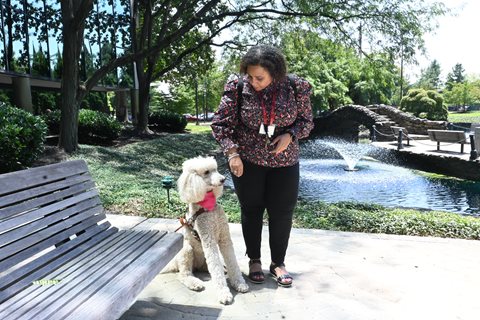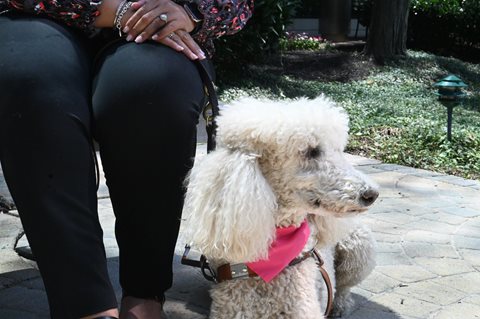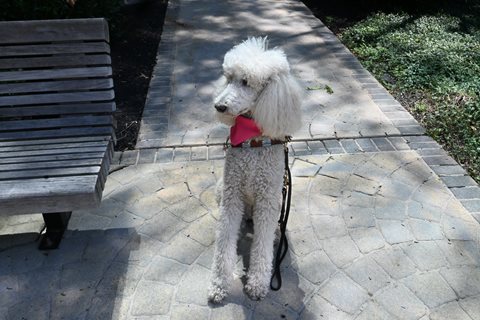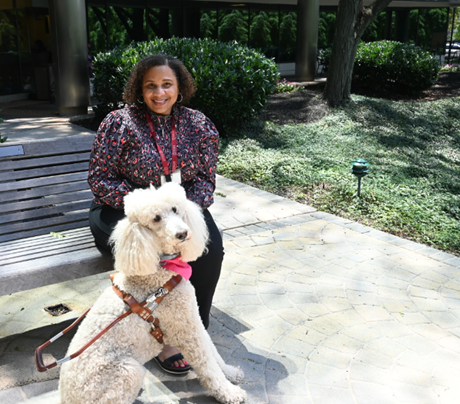International Assistance Dog Week, observed from Aug. 6 to Aug. 12, is a time to recognize worldwide all the devoted, hardworking assistance dogs helping individuals mitigate their disability-related limitations.

In this Q&A session, Lachelle Smith, MS ‘04, director of the Vision Rehabilitation Therapy (VRT) program, graciously shares the many ways her guide dog, Lyra, enriches her daily life.
Q: How has having a guide dog impacted your life and independence?
A: Having a guide dog has significantly impacted my life in several ways. My mobility has increased in that I am able to navigate different environments in a much more confident manner. Traveling with Lyra provides me a sense of comfort as she is trained to assist me with avoiding obstacles in my pathway such as openings in sidewalks, cones and sticks on a path, and running sprinklers and puddles! She navigates me to different places such as the restroom, elevator, doors, and store locations (she loves Starbucks for the pup cups). She will guide me to a certain person if asked and will guide me through crowds of people (she loves to do crowd work at the mall). Lastly, Lyra provides me with emotional comfort in that she is attuned to my emotional well-being, supporting me as a companion, stress reliever, and exercise partner (we walk anywhere from 2-5 miles several times a week).

Q: What should other people do when they see someone with a guide dog?
A: They should recognize the fact that the dog is working and should not distract the dog in any way. People should not stare at the dog, talk directly to the dog, touch the dog, or give the dog anything like treats.
Q: Why do you have a guide dog instead of a white cane?
A: I have used a white cane in the past and while it offered me safety in navigating through a space, it was limited to just that, detecting obstacles in my environment. With the guide dog, I have more options for not only safely navigating through an environment, the guide dog takes me to places I ask her to. She helps me find locations, people, items, and most notably, she offers me emotional support and a companion that I can connect with. Also, traveling with a guide dog allows me to move at a faster pace.
Q: What is a common misconception people have about guide dogs?
A: A common misconception is that the dog knows how to cross streets with their handler by following the traffic light. However, Guide dogs are given commands on where to go. They are taught how to travel a route by the handler and then given commands that the dog follows. I provide Lyra with commands that tell her where to take me. Now, there are places she knows to take me out of routine. I can tell Lyra to take me to the restroom without any further direction and she will guide me there. I can tell her to find my office, and she will. I can say find home if we are on a walk that we frequently take and she will take me there but I initially had to give her directions on how to find those places. Therefore, to have a guide dog, the handler must know where they want to go and how to get there and the dog will take them there.

Q: What advice would you give to someone who wants to have a guide dog?
A: Make sure they have good orientation and mobility skills first. These are needed to be effective with a guide dog for the reasons I mentioned above. Also, be prepared to have people stop you often to talk to your guide dog or pet it without permission. Also, be willing and prepared to educate the public about guide dog etiquette because people get so caught up in the dog, they do not even see or in some cases hear the handler ask them not to engage with the guide dog. The handler must also get used to being ignored. Oftentimes, the people will talk to the guide dog and not the handler. Lastly, one must be prepared for rejection in public spaces and environments. While there is a law that permits service animals access to public environments, there will be times when you and your guide dog will be denied access. This can be incredibly frustrating but these situations require education, patience, sometimes grade, and other times formal action.
Q: How long will your guide dog work?
A: It is estimated that many guide dogs work an average of 8-10 years with some working shorter or longer periods of time.

Q: Does your guide dog get distracted by other dogs?
A: Unfortunately, yes! Lyra is very much curious and excited when she sees other dogs. Sometimes she wags her tail in excitement, while other times she tries to take me to the other dog to say hello. Also, Lyra is a very vocal dog, which is common among poodle breeds. She sometimes will bark or growl when she sees other dogs. She is not being aggressive but vocal. This is not typical among service dogs though and is not ideal in any way. It is something I continue to work with her and the guide dog school trainers on but I have been told it is common among poodles. They like to talk!
Q: Does your guide dog get time off?
A: Yes, Lyra gets time off when she is at home or when we are in the office and her harness is off. A guide dog is working when you see them with their harness on but when it is off, they are technically not working. However, people should still follow the same rules as mentioned when the guide dog is working, only in this case, you can ask the handler if you may pet the guide dog.